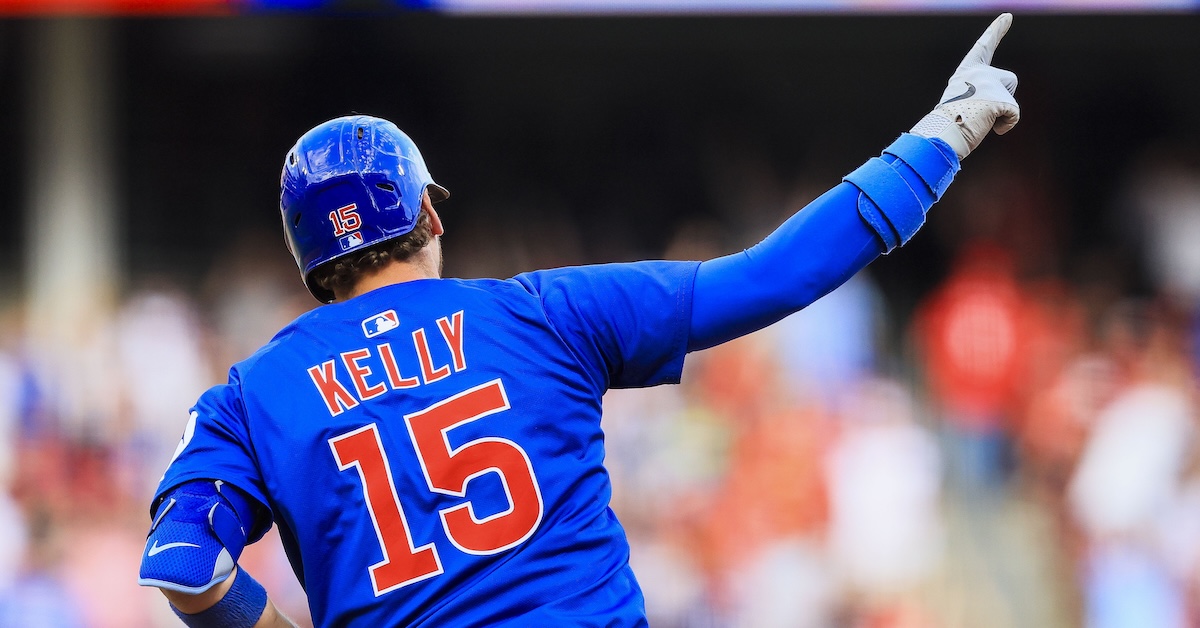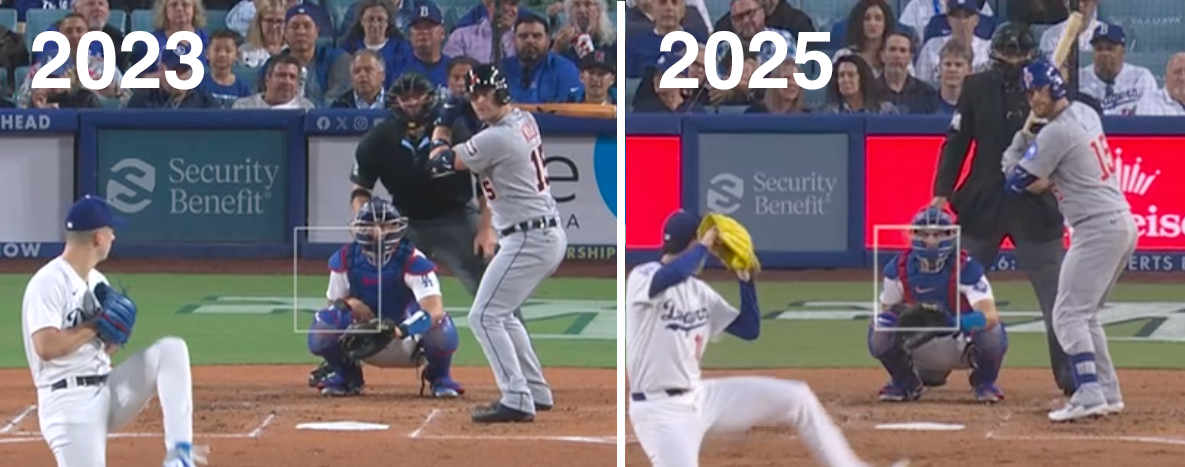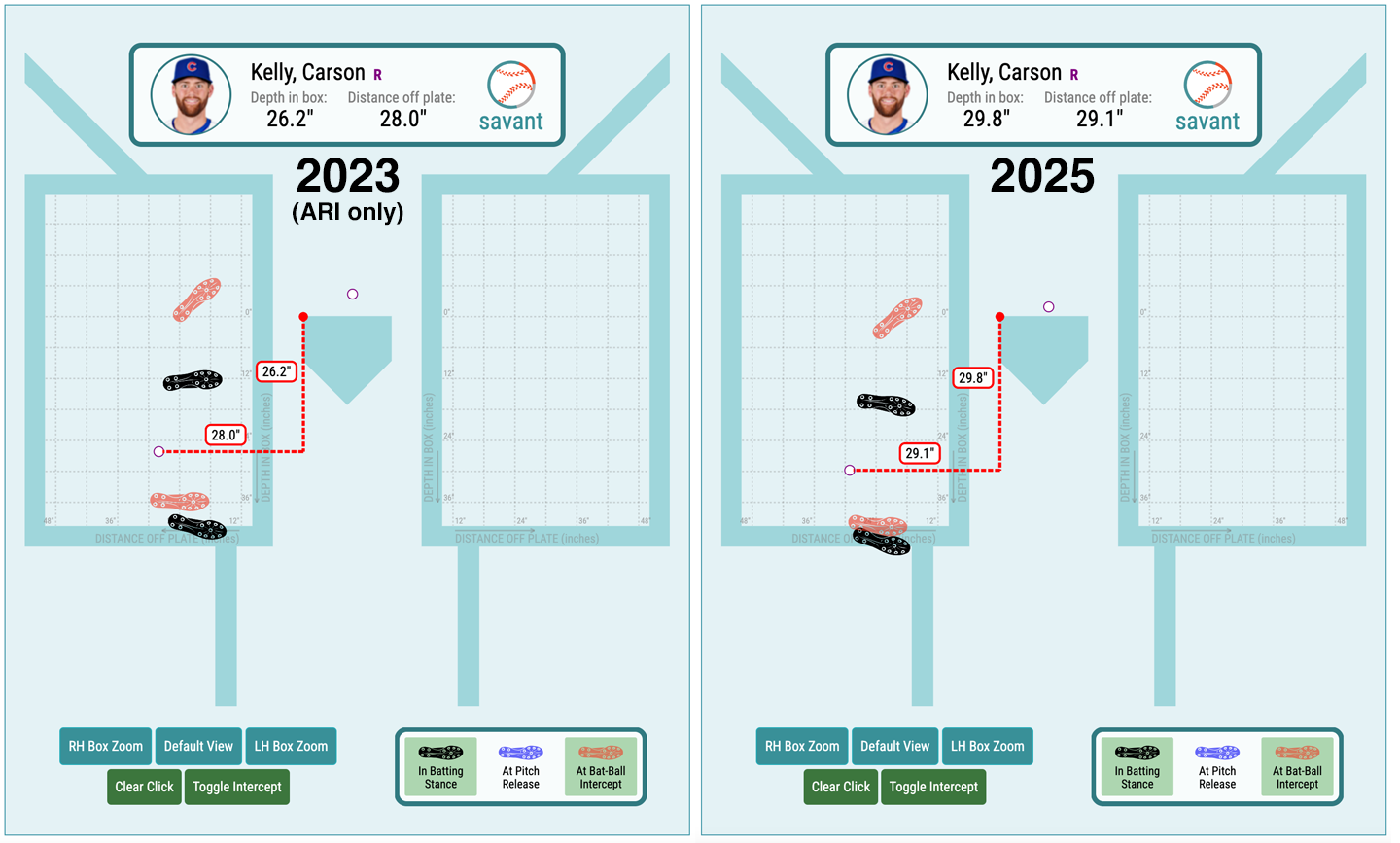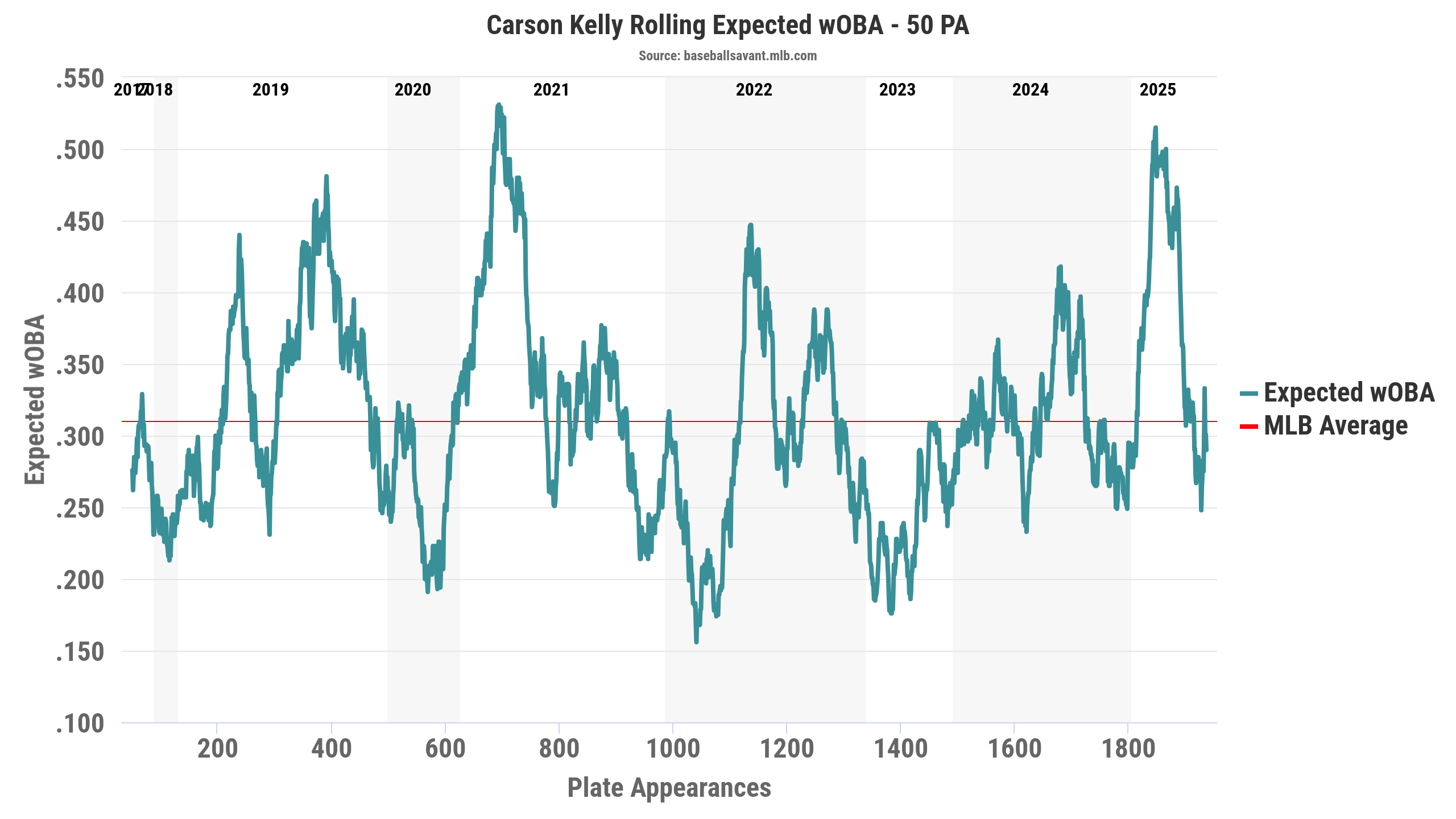Carson Kelly Has Caught on With the Cubs

As one-half of the majors’ most productive catching tandem, Carson Kelly doesn’t have enough plate appearances to qualify for the batting title, but like the Dodgers’ Will Smith, he’s been incredibly productive so far, particularly with runners in scoring position. Unlike Smith, he doesn’t have a lengthy track record of success; in parts of 10 major league seasons with five teams, Kelly has not only never made an All-Star team, he’s only played 100 games in a season twice, and finished with a 100 wRC+ or better just twice. But thanks to some changes to his swing mechanics over the past couple of seasons, he’s in the midst of a breakout campaign for the NL Central-leading Cubs.
The 30-year-old Kelly is hitting .290/.412/.589 with nine homers and a 179 wRC+ in 131 plate appearances. He’s started 28 of the Cubs’ 56 games behind the plate, while Miguel Amaya started 25 before landing on the injured list this past weekend due to an oblique strain, an injury that interrupted a promising start to the 26-year-old backstop’s season. Though Kelly homered after replacing Amaya in Saturday’s loss to the Reds, he was limited to a single late-inning cameo over the next three days due to an unspecified illness before returning to the lineup on Wednesday night. Instead of recalling 21-year-old prospect Moisés Ballesteros, who spent five games DHing for the Cubs earlier this month but whose defense needs more refinement, the Cubs brought up Reese McGuire from Triple-A Iowa to replace Amaya on the roster; he started all three games while Kelly was ailing, homering twice in his season debut against the Reds. All told, the trio of Cubs catchers has been great offensively:
| Player | G | PA | HR | BB% | K% | AVG | OBP | SLG | wRC+ | WAR |
|---|---|---|---|---|---|---|---|---|---|---|
| Carson Kelly | 30 | 120 | 9 | 15.0% | 13.3% | .310 | .417 | .630 | 190 | 1.7 |
| Miguel Amaya | 26 | 96 | 3 | 4.2% | 22.9% | .267 | .295 | .467 | 111 | 0.7 |
| Reese McGuire | 3 | 11 | 2 | 0.0% | 27.3% | .200 | .200 | .800 | 171 | 0.3 |
| Totals | 56 | 227 | 14 | 9.7% | 18.1% | .285 | .356 | .565 | 155 | 2.7 |
Together the Cubs’ catchers have the highest home run total, slugging percentage, and wRC+ of any team besides the Mariners, for whom Cal Raleigh is doing the heavy lifting. Individually, the Cubs trio’s hitting stats don’t stem from large samples, and Kelly’s performance in particular calls to mind an old stathead chestnut, Jazayerli’s Law of Backup Catchers: “[G]iven enough chances, a backup catcher will have a season in which he hits .300 in less than 200 at-bats.” I’m interpreting the law a bit more liberally with regards to Kelly’s overall offense, but this is still a player who owned a career slash line of .224/.307/.373 (85 wRC+) at the point the Cubs signed him to a two-year, $11.5 million deal last December.
Originally drafted by the Cardinals out of a Portland, Oregon high school — as a third baseman — in the second round in 2012, Kelly was once viewed as the heir apparent to Yadier Molina. He’d converted from third base to catcher in 2014, and three years later cracked Top 100 Prospect lists (he was 81st on ours) thanks to a combination of “rock-solid” defense behind the plate and “limited but inoffensive offensive ability,” to use Eric Longenhagen’s words. Kelly spent some time with the Cardinals from 2016–18, but the team never committed to him as Molina’s primary backup for very long, in part because he didn’t hit (.154/.227/.188, 16 wRC+ in 131 PA in those three season) and in part because Molina’s exceptional durability and staying power chased off more than one potential successor. In December 2018, the Cardinals traded Kelly to the Diamondbacks as part of the Paul Goldschmidt blockbuster, and he spent the next four seasons as Arizona’s regular catcher, hitting a combined .231/.318/.405 (95 wRC+) with 5.0 WAR in two good seasons and two lousy ones, with injuries contributing to his struggles.
During spring training in 2023, Kelly caught a bad break in the form of a fractured ulna, the result of an errant pitch from the White Sox’s Gregory Santos. By the time he returned to the roster on June 12, Gabriel Moreno had established himself in the majors, and in mid-August, after struggling mightily at the plate, the Diamondbacks released Kelly. He quickly caught on with the Tigers, who had plans for him. They encouraged him to adopt a one-knee crouch behind the plate, and after picking up his $3.5 million option that winter, helped him overhaul his swing, showing a notable measure of faith in a player who had produced a limp 56 wRC+ (.206/.278/.287) in his two stops that season. From an April 11 article in the Chicago Sun-Times by Maddie Lee:
He concentrated on bat speed and a more direct path to the ball, believing that would address his issues with low pitches and breaking balls.
“It was basically, try a lot of different things,” Kelly said. “We’re going to lower my hands; we’re going to put my hands higher. We’re going to change the bat angle of where we start.”
…Kelly landed on an athletic stance with his hands a little lower. And with a quicker, more efficient bat path, Kelly had more time to recognize pitches and make swing decisions.
Kelly’s offense rebounded, as he hit 108 wRC+ with the Tigers last year before being traded to the Rangers for Liam Hicks and Tyler Owens on July 28; at that point, Detroit was 52-55 and seemingly bound to play out the string. Of course, they went on a spree and snatched a Wild Card berth while Kelly’s Rangers — themselves just 51-55 at the time of the deal — languished below .500. Kelly regressed to an 81 wRC+ the rest of the way, and finished the year with a .238/.313/.374 (99 wRC+) line and 1.8 WAR, still his best showing in those last two categories since 2021.
Since signing with the Cubs, Kelly has continued to refine his swing in order to hit the ball in the air more often than last year, when his 46.3% groundball rate was his highest since his Cardinals days. “What grinded my gears was I’d get a pitch I could drive and I’d hit it into the ground,” he told The Athletic’s Sahadev Sharma in late April. More:
“One major change Kelly made was the weight distribution between his back and front foot. Previously, it was a 50-50 distribution. But now, force plate data tells him he’s more 70-30 weighted toward the back foot.”
Here’s a visual comparison of Kelly’s 2023 and ’25 stances:

Like Sharma, I chose Dodger Stadium so as to best keep the camera angle and backdrop consistent (not easy to do given Kelly’s uniform and league changes). You can see the lowered hands and a slight decrease in the extent to which he’s crouching. His Statcast batting stance and swing path metrics are somewhat noisy given his experimentation and his travels, but I think a comparison between his final stretch with the Diamondbacks (from the end of the All-Star break to his August 15 release) to his full 2024 and ’25 averages captures the changes reasonably well:
| Season | Avg Bat Sp | Swing Path | Attack Angle | Ideal % | Intercept | Depth | Distance | Feet | Stance Angle |
|---|---|---|---|---|---|---|---|---|---|
| 2023* | 69.2 | 31° | 11° | 50.7% | 4.4 | 26.2 | 28.0 | 26.8 | 2° OPEN |
| 2024 | 69.5 | 33° | 12° | 52.5% | 2.3 | 28.9 | 29.1 | 20.0 | 4° CLOSE |
| 2025 | 70.5 | 33° | 13° | 50.9% | 1.9 | 29.8 | 29.1 | 24.6 | 1° CLOSE |
Relative to the end of his tenure in Arizona, Kelly has moved back in the box by nearly three inches (Depth in the above table) and off the plate (Distance) by about an inch, this while closing up his stance and the distance between his feet by a couple of inches; he detoured from 26.8 inches in Arizona to 20 last year before opening up to 24.6 inches this year:

Additionally, Kelly has picked up a bit of bat speed and has increased the angles of his swing path (the arc of his swing) and attack (the vertical angle of his bat’s sweet spot), producing that sought-after loft. He’s making contact closer to the front of the plate (Intercept). Not shown in the table above but also relevant, he’s increased the angle at which he’s pulling the ball from two degrees to five degrees.
With all of that, Kelly’s quality of contact has improved dramatically. Relative to last year, he’s added three miles per hour in average exit velocity, added 1.6 degrees to his average launch angle (reflecting a groundball rate that’s dropped by 2.4 percentage points), doubled his barrel rate, and nearly doubled his pulled air rate:
| Season | BBE | EV | LA | Barrel% | HH% | GB% | Pull% | Pull Air% |
|---|---|---|---|---|---|---|---|---|
| 2022 | 250 | 87.7 | 14.7 | 5.2% | 36.8% | 40.8% | 38.8% | 17.2% |
| 2023 | 97 | 86.8 | 15.6 | 2.1% | 32.0% | 42.3% | 33.0% | 14.4% |
| 2024 | 227 | 87.6 | 13.6 | 6.6% | 38.8% | 46.3% | 38.8% | 12.8% |
| 2025 | 91 | 90.7 | 15.2 | 13.2% | 45.1% | 42.9% | 44.0% | 23.1% |
Kelly’s 3.1-mph average exit velocity gain is the 11th-largest among players with at least 300 PA last year and 100 this year, while his 6.6% increase in barrel rate is 14th. He’s raised his expected slugging percentage by nearly 140 points relative to last year and has almost doubled it relative to his rough 2023 season:
| Season | AVG | xBA | SLG | xSLG | wOBA | xwOBA |
|---|---|---|---|---|---|---|
| 2022 | .211 | .225 | .334 | .345 | .275 | .288 |
| 2023 | .206 | .185 | .287 | .279 | .255 | .245 |
| 2024 | .238 | .235 | .374 | .401 | .304 | .314 |
| 2025 | .290 | .272 | .589 | .538 | .429 | .400 |
Kelly is outdoing his expected numbers, but not by so much that his performance is particularly fluky. He’s improved substantially, augmented by his exceptional plate discipline: He’s cut his chase rate from 23.5% to a career-low 17.9%, and with it, trimmed his swinging strike rate from 9.5% to 8.1%. With that, he’s walking a career-high 16.8% of the time (almost seven points above his career mark) and striking out just 13% of the time (almost seven points below his career mark). What really caught my eye is how he’s controlled the strike zone with runners in scoring position, something I discovered in the process of researching Smith earlier this week:
| Player | Tm | PA | BB% | K% | AVG | OBP | SLG | wRC+ |
|---|---|---|---|---|---|---|---|---|
| Carson Kelly | CHC | 42 | 21.4% | 4.8% | .375 | .500 | .844 | 257 |
| Teoscar Hernández | LAD | 50 | 2.0% | 20.0% | .447 | .449 | .830 | 253 |
| Aaron Judge | NYY | 56 | 25.0% | 19.6% | .450 | .589 | .750 | 251 |
| Will Smith | LAD | 57 | 15.8% | 14.0% | .477 | .544 | .750 | 248 |
| Jacob Wilson | ATH | 53 | 13.2% | 1.9% | .444 | .528 | .600 | 226 |
| Wilmer Flores | SFG | 59 | 15.3% | 15.3% | .380 | .475 | .680 | 222 |
| Paul Goldschmidt | NYY | 57 | 12.3% | 15.8% | .458 | .526 | .604 | 219 |
| Rafael Devers | BOS | 85 | 21.2% | 17.6% | .354 | .482 | .692 | 214 |
| Freddie Freeman | LAD | 56 | 17.9% | 17.9% | .381 | .482 | .690 | 203 |
| Seiya Suzuki | CHC | 77 | 10.4% | 26.0% | .354 | .403 | .723 | 201 |
| J.P. Crawford | SEA | 51 | 19.6% | 11.8% | .333 | .469 | .538 | 200 |
| Pete Crow-Armstrong | CHC | 70 | 1.4% | 27.1% | .338 | .338 | .754 | 196 |
| Pete Alonso | NYM | 74 | 21.6% | 17.6% | .321 | .473 | .623 | 196 |
| Bryce Harper | PHI | 60 | 15.0% | 10.0% | .354 | .450 | .646 | 191 |
| Jonathan Aranda | TBR | 45 | 6.7% | 24.4% | .366 | .400 | .610 | 189 |
| Javier Báez | DET | 44 | 2.3% | 18.2% | .349 | .364 | .651 | 189 |
Those aren’t typos. Kelly is walking over four times as often as he’s striking out with runners in scoring position, which has helped him to the highest wRC+ of any batter with at least 40 PA in such situations. Unlike Smith, who chases much more often with men in scoring position than with the bases empty (27.4% vs. 12.9%), Kelly has resisted chasing in those situations (17.4% vs. 21.5%). As it turns out, even though he didn’t hit the ball as hard last year, Kelly was very good with runners in scoring position as well (.328/.455/.639, 208 wRC+ in 77 PA), with a higher walk rate than strikeout rate (14.3% vs. 7.8%) and even a nearly identical chase rate in such situations (17.5%).
If you’re wondering whether Kelly is going to sustain such a hot start, the answer is already, “He hasn’t.” For as strong as his current numbers are, his regression is already underway, in that he’s hit just .228/.313/.368 (96 wRC+) in 64 PA in May, compared to .360/.507/.840 (258 wRC+) in 67 PA in March and April. Over that more recent span, he’s barreled 10.9% of his batted balls, albeit with just a 30.4% hard-hit rate and an average exit velocity of 87.6 mph. The real question is whether he can come closer to recapturing what he did last month, though he does appear to be trending upwards again:

With Amaya out for four to six weeks, Kelly figures to get the bulk of the playing time, which means he’ll be more exposed and incur more of the wear and tear that bogs down even the most productive catchers when they’re worked hard. Still, the success he’s tasted recently bodes well, giving him a reference point for what’s worked, and while he’ll have to adjust as pitchers account for that, he’s already shown the flexibility to do so.
Brooklyn-based Jay Jaffe is a senior writer for FanGraphs, the author of The Cooperstown Casebook (Thomas Dunne Books, 2017) and the creator of the JAWS (Jaffe WAR Score) metric for Hall of Fame analysis. He founded the Futility Infielder website (2001), was a columnist for Baseball Prospectus (2005-2012) and a contributing writer for Sports Illustrated (2012-2018). He has been a recurring guest on MLB Network and a member of the BBWAA since 2011, and a Hall of Fame voter since 2021. Follow him on BlueSky @jayjaffe.bsky.social.
Cubs catchers this year ranked by wRC+
Kelly 179
Reese 170
Amaya 127
Now obviously it’s all sss luck babip etc. But still is fun to see.